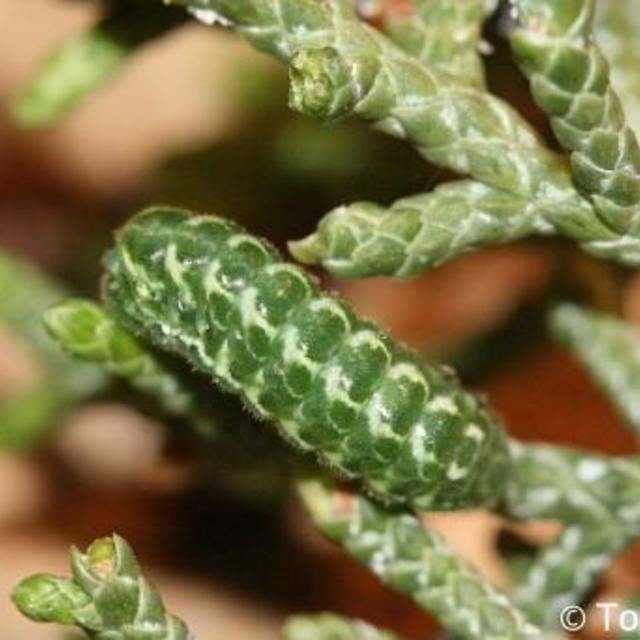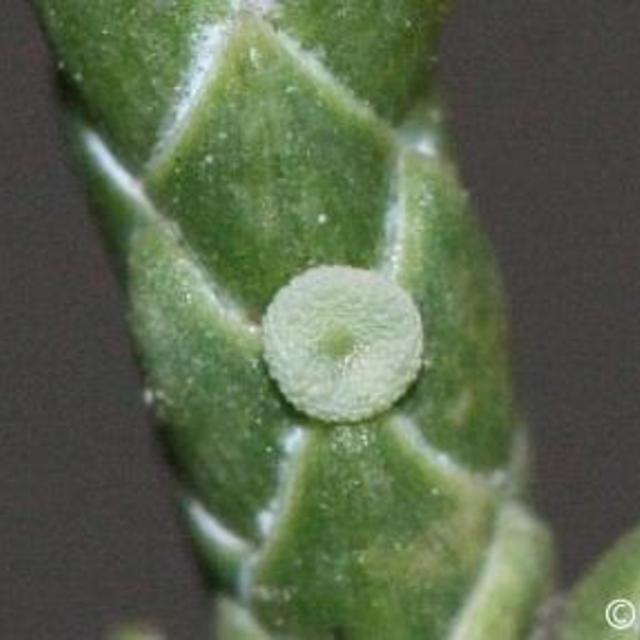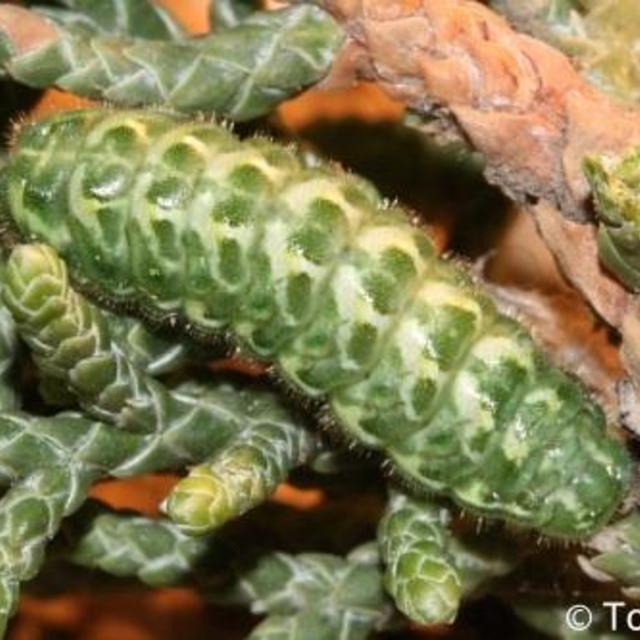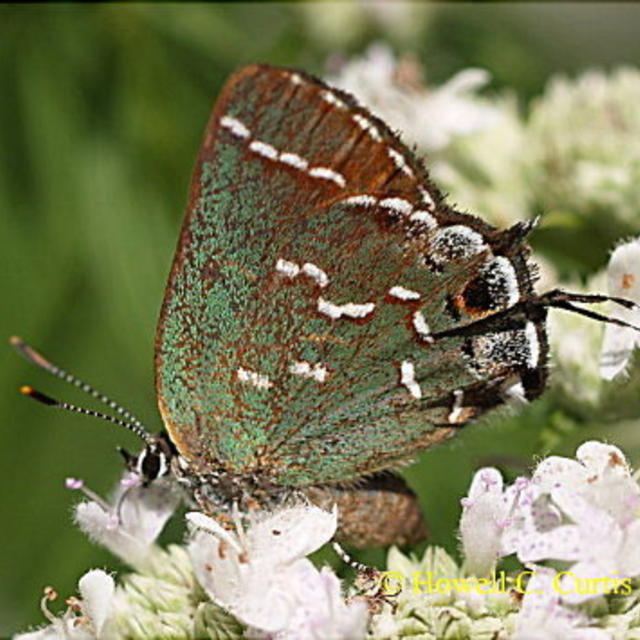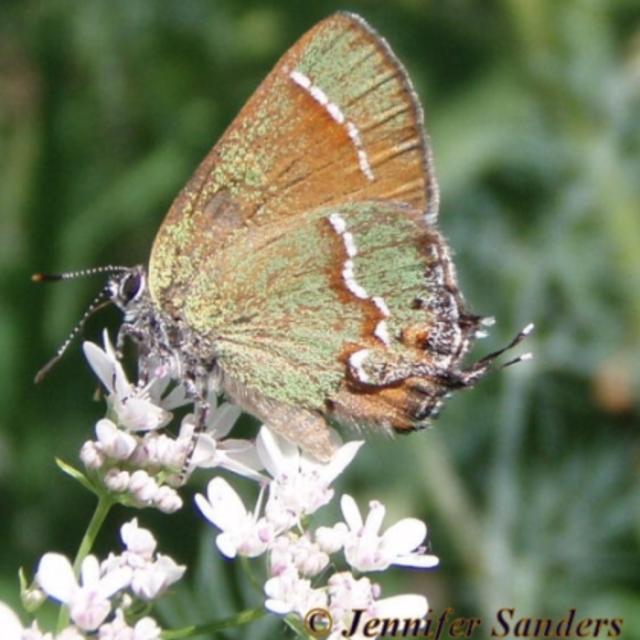Juniper Hairstreak
Callophrys gryneus (Hübner, [1819])
Family: Lycaenidae
Subfamily: Theclinae
Identification: Widespread and variable. Western and eastern populations were once considered separate species but have been found to hybridize. Western: Upperside of male dull red-brown, female tawny; both with dark brown costa and wing borders. Underside of forewing rust-red; hindwing dull to bright green with irregular white line edged inwardly with red-brown. Eastern: Upperside of male dark brown with olive-colored sheen, female blackish brown. Underside green; forewing with tawny base, hindwing with 2 white spots near base and irregular white line edged inwardly with red-brown.
Wing Span: 1 - 1 1/4 inches (2.6 - 3.2 cm).
Life History: To seek females, males perch on host trees all day. Eggs are laid singly on tips of host plant leaves, which the caterpillars eat. Chrysalids hibernate.
Flight: In the far north of its range (Canada) except in southern Quebec at Point Pelee, where the second flight has been recorded (Layberry 1998). One brood from May-August; in the west, one brood from March-July. Two broods in the rest of its range, from Februa
Caterpillar Hosts: Redcedar scopulorum), California juniper (J. californica), Utah juniper (J. osteosperma), and perhaps others.
Adult Food: Nectar from various flowers including winter cress, dogbane, common milkweed, wild carrot, shepherd's needle, butterflyweed, white sweet clover, and others.
Habitat: Old fields, bluffs, barrens, juniper and pinyon-juniper woodlands, and cedar breaks.
Range: East Texas. West: Montana, North Dakota, and Nebraska south to southern California, Arizona, New Mexico, and Baja California.
Conservation: Subspecies sweadneri is of conservation concern wherever it is found. Callophrys gryneus as a whole has The Nature Conservancy Global Rank of G5 - Demonstrably secure globally, though it may be quite rare in parts of its range, especially at the periphery. Subspecies siva and loki have The Nature Conservancy rank of T4 - Apparently secure globally, though it might be quite rare in parts of its range, especially at the periphery. Subspecies sweadneri in Florida has The Nature Conservancy rank of T2 - Imperiled globally because of rarity (6 to 20 occurrences), or because of other factors demonstrably making it very vulnerable to extinction throughout its range. (Endangered throughout its range).
NCGR:
Management Needs: Maintain habitat of subspecies sweadneri and manage for the proper successional stage.
Alternate Scientific Names:
Callophrys grynea
Callophrys grynes
Mitoura grynea
Mitoura gryneus
Please donate!
We depend on donations to keep Butterflies and Moths of North America freely available. We want to express our gratitude to all who showed their support by making a contribution this year. You can donate to support this project at any time.
Advertise with us!
Do you have a product or service that you think would interest BAMONA users? If you would like to advertise on this website, contact us by email, or use the contact form and select the "Advertising" category.
Verified Sightings
Displaying 1 - 24 of 2544 verified sightings

Observation date: Jun 28, 2025
Submitted by: J_Martineau
Region:
Verified by: J_Martineau
Verified date: Dec 13, 2025

Observation date: Sep 19, 2025
Submitted by: bjones7777
Region: San Bernardino County, California, United States
Verified by: Ken Davenport
Verified date: Oct 03, 2025

Observation date: Jun 10, 2025
Submitted by: MinPinLord
Region: British Columbia, Canada
Verified by: Paul Prappas
Verified date: Aug 12, 2025

Observation date: Aug 11, 2025
Submitted by: jmgesell
Region: Dare County, North Carolina, United States
Verified by: Dennis Forsythe
Verified date: Aug 12, 2025

Observation date: May 20, 2016
Submitted by: regina rochefort
Region: Whatcom County, Washington, United States
Verified by: davidwdroppers
Verified date: Jul 25, 2025

Observation date: May 09, 2025
Submitted by: DeerPark
Region: Thurston County, Washington, United States
Verified by: davidwdroppers
Verified date: Jul 16, 2025

Observation date: May 28, 2025
Submitted by: PDunwiddie
Region: San Juan County, Washington, United States
Verified by: davidwdroppers
Verified date: Jun 08, 2025

Observation date: Apr 29, 2024
Submitted by: hasfitz5
Region: Cochise County, Arizona, United States
Verified by: John Saba
Verified date: May 18, 2025

Observation date: May 11, 2025
Submitted by: TJM321
Region: Texas, Williamson County, United States
Verified by: jwileyrains
Verified date: May 12, 2025

Observation date: May 09, 2025
Submitted by: sandyleapt
Region: Multnomah County, Oregon, United States
Verified by: Ken Davenport
Verified date: May 11, 2025

Observation date: May 03, 2025
Submitted by: gpro111
Region: Citrus County, Florida, United States
Verified by: John Calhoun
Verified date: May 03, 2025

Observation date: Apr 24, 2025
Submitted by: Marta Reece
Region: Lincoln County, New Mexico, United States
Verified by: stevecary
Verified date: Apr 27, 2025

Observation date: Apr 14, 2025
Submitted by: jmgesell
Region: Northampton County, Pennsylvania, United States
Verified by: davidwright
Verified date: Apr 23, 2025

Observation date: Apr 20, 2025
Submitted by: camflies
Region: Santa Barbara County, California, United States
Verified by: Ken Davenport
Verified date: Apr 21, 2025

Observation date: Apr 12, 2025
Submitted by: eperry
Region: Hays County, Texas, United States
Verified by: jwileyrains
Verified date: Apr 20, 2025

Observation date: Mar 28, 2025
Submitted by: Tdloyd
Region: Sumner County, Tennessee, United States
Verified by: James Steen
Verified date: Mar 28, 2025

Observation date: Mar 25, 2025
Submitted by: Sheilabean
Region: Johnson County, Texas, United States
Verified by: jwileyrains
Verified date: Mar 26, 2025

Observation date: May 04, 2017
Submitted by: BarbSendelbach
Region: Sussex County, New Jersey, United States
Verified by: BarbSendelbach
Verified date: Jan 15, 2025

Observation date: Sep 09, 2023
Submitted by: BarbSendelbach
Region: Sussex County, New Jersey, United States
Verified by: BarbSendelbach
Verified date: Jan 15, 2025

Observation date: Sep 06, 2023
Submitted by: BarbSendelbach
Region: Sussex County, New Jersey, United States
Verified by: BarbSendelbach
Verified date: Jan 15, 2025

Observation date: Sep 02, 2023
Submitted by: BarbSendelbach
Region: Sussex County, New Jersey, United States
Verified by: BarbSendelbach
Verified date: Jan 15, 2025

Observation date: Apr 12, 2017
Submitted by: tiki33wv
Region: Cochise County, Arizona, United States
Verified by: John Saba
Verified date: Dec 06, 2024

Observation date: Apr 24, 2023
Submitted by: patcole@mac.com
Region: Mercer County, New Jersey, United States
Verified by: jwileyrains
Verified date: Nov 17, 2024

Observation date: Aug 01, 2014
Submitted by: jrtindall
Region: Ocean County, New Jersey, United States
Verified by: jwileyrains
Verified date: Nov 17, 2024
- 1 of 106
- next ›


